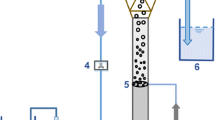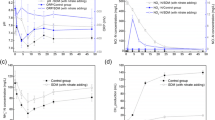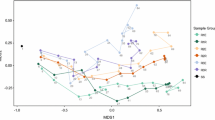Abstract
Mature granules and flocs from aerobic sludge were collected from the wastewater treatment plant (WWTP) treating both municipal and industrial effluents in Haining city China. This plant has been operating under conditions favoring aerobic granular sludge formation, for over 3 years, suggesting that the granules, which stably retained under changing effluent conditions, may contain unique microbial populations. Microbial analysis indicated that the granular sludge was primarily composed of Planctomycetes, Proteobacteria and Bacteroidetes from the bacterial phyla. Interestingly, microbial communities were also observed to be stratified between the structural features of the sludge. For example, Euryarchaeota was found to make up the majority of the archaea found in the granules while Methanosaeta was dominant in the flocs. Additionally, granules were found to contain, 34 phyla and 222 genera of bacteria, 4 phyla and 13 genera of fungi, and 2 phyla and 17 genera of archaea. While flocs contained, 32 phyla and 203 genera of bacteria, 6 phyla and 26 genera of fungi, and 2 phyla and 12 genera of archaea. This biodiversity signifying a preservation of bacterial and archaeal population in granules, and fungal populations in flocs may result from the sedimentary characteristics of the granules. This suggests microbes uniquely associated in the granules are playing a key role in structure formation and stability of the granular ecosystem, which is maintained by the longer sludge retention time.





Similar content being viewed by others

References
Adav SS, Lee DJ, Show KY, Tay JH (2008) Aerobic granular sludge: recent advances. Biotechnol Adv 26(5):411–423
APHA (2006) Standard methods for the examination of water and wastewater, 21st edn. American Public Health Association, Washington
Cydzik-Kwiatkowska A, Wojnowska-Baryła I (2015) Nitrogen-converting communities in aerobic granules at different hydraulic retention times (HRTs) and operational modes. World J Microbiol Biotechnol 31:75–83
de Kreuk MK (2006) Aerobic granular sludge: scaling up a new technology. Delft University of Technology, TU Delft
Enrigt AM, Collins G, Flaherty VO (2007) Temporal microbial diversity changes in solvent degrading anaerobic granular sludge from low temperature (15 °C) wastewater treatment bioreactors. Syst Appl Microbiol 30(6):471–482
Gao DW, Liu L, Liang H, Wu WM (2011) Aerobic granular sludge: characterization, mechanism of granulation and application to wastewater treatment. Crit Rev Biotechnol 31(2):137–152
Giesen A, de Bruin LMM, Niermans RP, van der Roest HF (2013) Advancements in the application of aerobic granular biomass technology for sustainable treatment of wastewater. Water Pract Technol 8(1):47–54
Gonzalez-Gil G, Holliger C (2014) Aerobic granules: microbial landscape and architecture, stages, and practical implications. Appl Environ Microbiol 80(11):3433–3441
Gray ND, Miskin IP, Kornilova O, Curtis TP, Head IM (2002) Occurrence and activity of archaea in aerated activated sludge wastewater treatment plants. Environ Microbiol 4(3):158–168
Guo F, Zhang SH, Yu X, Wei B (2011) Variations of both bacterial community and extracellular polymers: the inducements of increase of cell hydrophobicity from biofloc to aerobic granular sludge. Bioresour Technol 102(11):6421–6428
Hiraswa JS, Sarti A, Aguila NKS, Varesche MBA (2008) Application of molecular techniques to evaluate the methanogenic archaea and anaerobic bacteria in the presence of oxygen with different COD: sulfate ratios in a UASB reactor. Anaerobe 14(4):209–210
Huang KL, Zhang XX, Shi P, Wu B, Ren HQ (2014) A comprehensive insight into bacterial virulence in drinking water using 454 pyrosequencing and illumina high-throughput sequencing. Ecotoxicol Environ Saf 109:15–21
Huang WL, Li B, Zhang C, Zhang ZY, Lei ZF, Lu BW, Zhou BL (2015) Effect of algae growth on aerobic granulation and nutrients removal from synthetic wastewater by using sequencing batch reactors. Bioresour Technol 179:187–192
Hughes JB, Hellmann JJ, Ricketts TH, Bohannan BJ (2001) Counting the uncountable: statistical approaches to estimating microbial diversity. Appl Environ Microbiol 67(10):4399–4406
Jungles MK, Figueroa M, Morales N, Val del Río A, da Costa RHR, Campos JL, Mendez R (2011) Start up of a pilot scale aerobic granular reactor for organic matter and nitrogen removal. J Chem Technol Biotechnol 86(5):763–768
Khan MZ, Mondal PK, Sabir S (2013) Aerobic granulation for wastewater bioremediation: a review. Can J Chem Eng 91(6):1045–1058
Lee DJ, Chen TY, Show KY, Whiteley CG, Tay JH (2010) Advances in aerobic granule formation and granule stability in the course of storage and reactor operation. Biotechnol Adv 28(6):919–934
Li J, Ding LB, Cai A, Huang GX, Horn H (2014) Aerobic sludge granulation in a full-scale sequencing batch reactor. BioMed Res Int. doi:10.1155/2014/268789
Liu H, Li GW, Li XF, Chen J (2008) Molecular characterization of bacterial community in aerobic granular sludge stressed by pentachlorophenol. J Environ Sci (China) 20(10):1243–1249
Liu YQ, Kong YH, Tay JH, Zhu JR (2011) Enhancement of start-up of pilot-scale granular SBR fed with real wastewater. Sep Purif Technol 82:190–196
Mckeown RM, Scully C, Enrigt AM, Chinalia FA, Lee C, Mahony T, Collins G, O’Flaherty V (2009) Psychrophilic methanogenic community development during long term cultivation of anaerobic granular biofilms. ISME J 3(11):1231–1242
McLellan SL, Huse SM, Mueller-Spitz SR, Andreishcheva EN, Sogin ML (2010) Diversity and population structure of sewage-derived microorganisms in wastewater treatment plant influent. Environ Microbiol 12(2):378-392
Morales N, Figueroa M, Fra-Vázquez A, Val del Río A, Campos JL, Mosquera-Corral A, Méndez R (2013) Operation of an aerobic granular pilot scale SBR plant to treat swine slurry. Process Biochem 48(8):1216–1221
More TT, Yan S, Tyagi RD, Surampalli RY (2010) Potential use of filamentous fungi for wastewater sludge treatment. Bioresour Technol 101(20):7691–7700
Morgenroth E, Sherden T, Van Loosdrecht MCM, Heijnen JJ, Wilderer PA (1997) Aerobic granular sludge in a sequencing batch reactor. Water Res 31(12):3191–3194
Ni BJ, Xie WM, Liu SG, Yu HQ, Wang YZ, Wang G, Dai XL (2009) Granulation of activated sludge in a pilot-scale sequencing batch reactor for treatment of low-strength municipal wastewater. Water Res 43(3):751–761
Rocktaschel T, Klarmann C, Ochoa J, Boisson P, Sorensen K, Horn H (2015) Influence of the granulation grade on the concentration of suspended solids in the effluent of a pilot scale sequencing batch reactor operated with aerobic granular sludge. Sep Purif Technol 142:234–241
Roesch L, Fulthorpe R, Riva A, Casella G, Hadwin A, Ken AD, Daroub SH, Canargo FA, Farmerie WG, Triplett EW (2007) Pyrosequencing enumerates and contrasts soil microbial diversity. ISME J 1(4):283–290
Show KY, Lee DJ, Tay JH (2011) Aerobic granulation: advances and challenges. Appl Biochem Biotechnol 167(6):1622–1640
Subramanian SB, Yan S, Tyagi RD, Surampalli RY (2008) A new, pellet-forming fungal strain: its isolation, molecular identification, and performance for simultaneous sludge-solids reduction, flocculation, and dewatering. Water Environ Res 80(9):840–852
Subramanian S, Yan S, Tyagi R, Surampalli R (2010) SSPRSD using a filamentous fungal strain Penicillium expansum BS30 isolated from wastewater sludge. J Environ Eng 136(7):719–730
Weber SD, Hofmann A, Pilhofer M, Wanner G, Agerer R, Ludwig W, Schleifer KH, Fried J (2009a) The diversity of fungi in aerobic sewage granules assessed by 18S rRNA gene and ITS sequence analyses. FEMS Microbiol Ecol 68(2):246–254
Weber SD, Ludwig W, Schleifer KH, Fried J (2009b) Microbial composition and structure of aerobic granular sewage biofilms. Appl Environ Microbiol 73(19):6233–6240
Yang QX, Wang J, Wang HT, Chen XY, Ren SW, Li XL, Zhang H, Li XM (2012) Evolution of the microbial community in a full-scale printing and dyeing wastewater treatment system. Bioresour Technol 117:155–163
Zhang T, Shao MF, Lin Y (2012) 454 Pyrosequencing reveals bacterial diversity of activated sludge from 14 sewage treatment plant. ISME J 6(6):1137–1147
Acknowledgements
This study was funded by the National Natural Science Foundation of China (51478433). The authors thank Dr. Jonathan Perreault and Philippe Constant for helpful discussions and revision.
Author information
Authors and Affiliations
Corresponding author
Rights and permissions
About this article
Cite this article
Liu, J., Li, J., Tao, Y. et al. Analysis of bacterial, fungal and archaeal populations from a municipal wastewater treatment plant developing an innovative aerobic granular sludge process. World J Microbiol Biotechnol 33, 14 (2017). https://doi.org/10.1007/s11274-016-2179-0
Received:
Accepted:
Published:
DOI: https://doi.org/10.1007/s11274-016-2179-0



